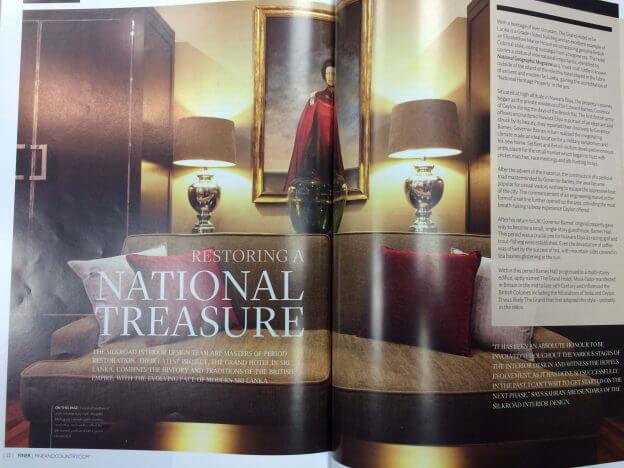
RESTORING A NATIONAL TREASURE
With a heritage of over 120 years, this Grade 1 listed building has benefitted from superior hotel design and interior design. Once an excellent example of an Elizabethan Manor House encompassing genuine British Colonial style, and oozing nostalgia from a bygone era. Currently, The Hotel carries a status of International Importance, indeed it was identified by National Geographic Magazine a ‘must visit’ when in Sri Lanka. Little is known outside of the island of the role that this hotel played in the fabric of ancient and modern Sri Lanka, gaining the accreditation of ‘National Heritage Property’ by the Department of Archaeology in the Nineties.
The Days of The Raj
Situated at high altitude in Nuwara Eliya, Sri Lanka (known as ‘Little England’ or ‘Switzerland of the East’) the property’s journey began as the private residence of Sir Edward Barnes, Governor of Ceylon during the days of the British Raj. Governor Barnes realised that the invigorating climate made it an ideal location for a military sanatorium and for his new home. Settlers and British visitors soon developed enormous enthusiasm for the small hamlet which quickly began to buzz with cricket
matches, race meetings and elk hunting.
After the advent of the motorcar, and the construction of a perilous road, the area became more popular for the casual visitors wishing to escape the oppressive heat of the City. This time also saw the commencement of an engineering marvel in the form of a rail line. This rail journey provided the most adventurous and breath-taking railway experience Ceylon offered and remains to this day the most popular mode of transport to Nuwara Eliya.
The Birth of a Hotel
After his return to the UK, and with Nuwara Eliya more accessible and growing in popularity, Governor Barnes’ original property gave way to become a small, basic single-story guesthouse, ‘Barnes Hall’. This period became a crucial one for Nuwara Eliya, even the devastation of coffee was offset by the success of tea with mountainsides covered in teach bushes glistening in the sun. Within this period ‘Barnes Hall’ progressed from basic hotel to multi-storey and the beginnings of the aptly named ‘Grand Hotel’. Mock-tudor first manifested in Britain in the mid to late 19th Century and quickly became an influence in the British Colonies including the hill stations of India and Ceylon. It almost certainly was the Grand that first adopted the mock-tudor style – probably in the 1880’s when the hotel was converted from ‘Barnes Hall’.
To meet the increased demand for accommodation of a high standard, expansion of The Grand Hotel became essential and such was its success that the hotel soon gained promotion to ‘Vice-regal residence’ after becoming a favourite haunt for royalty. By the 1930’s the third floor had been added to the hotel and on February 4th, 1948 Ceylon gained independence from the British and a new era dawned for this gem of a hotel.
Today
Sympathetic hotel design has ensured every corner of the hotel has retained its grandeur. This hotel is steeped in history and the ‘British-ness’ with beautiful craftsmanship and fine architectural details still visible, amongst the rambling corridors and their fine dados and elegant cornicing in teak, the ornate lounges and the hidden dens blend beautifully with the new wing which offers sophisticated and fine dining. Soaring ceilings, wooden floors throughout and solid wooden doors as well as a diversity of period furniture complete the overall look of the hotel.
Retaining ‘Old England’ Even the charm and beauty of the surrounding gardens emit the quaint charm of ‘Old England’, with plant-filled gardens and beautifully manicured lawns with parasol-shaded sets of wrought iron furniture. There is no doubt that from around the inception of Nuwara Eliya, the British residents understood the need to transform the appearance of the landscape into an English countryside by introducing native plants.
Hotels such as this do not enjoy the luxury of being able to stand still in time and whilst preserving and respecting its history, progression is vital. As such an ambitious interior renovation project to span two further years is planned, the interior works having begun in 2010.
A Wealth of Archive Information
The Interior Design arm of ‘Silkroad Interiors and Flooring’ have already completed the internal reception areas as well as introducing two new dining experiences: a Thai Restaurant and the Tea Lounge and Tea Veranda. The Tea Lounge was ingeniously transformed from an office during the renovations in 2012 with gold wallpaper lining the walls offsetting hand-painted vintage tea posters and display cabinets filled with antique copper, brass and silver tea sets.
Antique furniture, original ironmongery for the fire surrounds and door furniture as well as all the silverware was personally sourced by the interior designers in the UK and imported to Sri Lanka. The importance of authenticity is uncompromised. The Tea Veranda – an entirely new structure – sympathetically unites ‘original’ and ‘new’ and provides one of the best places to view the landscape of the tea country.
First impressions are striking and upon entering through the portal you will proceed in to the doorman’s ante-room – a reminder of the days when visitors on horseback would remove their protective clothing before entering the hotel welcoming large, blackened wrought iron fire places which still burn logs today as has happened throughout the hotel’s distinguished past. The hotel capitalises on its history and everywhere there are glimpses of days gone by with an invaluable collection of archive photography.
Gold Buttoned Uniforms and Vanilla Tea
The newly renovated and stylish reception lobby more than nods to the days of the Empire with heavily framed coronation portraits of the British Royal family. In contrast, on the opposite wall are photographs of tea plantation workers who were responsible for creating the wealth of the Empire. The furniture and wall panelling were chosen using existing designs found elsewhere in the hotel as well as those invaluable archive images. Instead of the usual check-in mayhem, guests are ushered into the adjacent lounge, given a hot face towel, proffered with silver tongs by a waiter in a uniform consisting of a white tunic, with gold-coloured buttons and white sarong and then there’s the welcome drink: Vanilla Tea.
Perhaps the most precious and unique part of the hotel is the Billiards Room which remains untouched with its timber planked ceilings and exposed wooden trusses. Three antique full-sized billiards tables dominate the room made by Burroughes and Watts of London, who helped pioneer the game and were given a royal patronage by Queen Victoria (a keen billiards player herself). Original cues survive as do a collection of 35 ivory billiards balls, their colour faded, but nevertheless a fascinating addition to what is essentially a billiard’s museum.
Character and Colonialism
Interior redecoration has now shifted to the bedrooms and suites with the opening of the new ‘Queen Elizabeth II Suite’ (images of this completed suite can be seen on our portfolio page). Each bedroom is difference in size and aspect which naturally affords the interiors designers the change to individualise – always ensuring the essential character and colonialism is retained throughout.
Still Partying On
The Grand Hotel is that rare treat which successfully manages to move forward with the ever-changing world of tourism. It effortlessly retains its record of an age that sadly seems to be slipping away. The hotel has lost little of its Edwardian charm whilst keeping up with the demands of the modern-day visitor.

